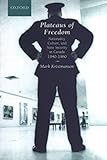Plateaus of Freedom : Nationality, Culture, and State Security in Canada, 1940-1960 / Mark Kristmanson.
Material type: TextSeries: Canadian Social History SeriesPublisher: Toronto : University of Toronto Press, [2003]Copyright date: ©2002Description: 1 online resource (319 p.)Content type:
TextSeries: Canadian Social History SeriesPublisher: Toronto : University of Toronto Press, [2003]Copyright date: ©2002Description: 1 online resource (319 p.)Content type: - 9780195418033
- 9781442623156
- 971.063
- F1021.2
- online - DeGruyter
| Item type | Current library | Call number | URL | Status | Notes | Barcode | |
|---|---|---|---|---|---|---|---|
 eBook
eBook
|
Biblioteca "Angelicum" Pont. Univ. S.Tommaso d'Aquino Nuvola online | online - DeGruyter (Browse shelf(Opens below)) | Online access | Not for loan (Accesso limitato) | Accesso per gli utenti autorizzati / Access for authorized users | (dgr)9781442623156 |
restricted access online access with authorization star
http://purl.org/coar/access_right/c_16ec
'Canadians are not accustomed to thinking of censorship, secret intelligence, and propaganda as a single entity. Much less do they consider that these covertly militaristic activities have anything to do with culture.' So writes Mark Krismanson in this important study of the intertwining activities and careers of those involved in Canada's security agencies and in the state-sanctioned culture industry during the delight of the Cold War. The connections between secret intelligence and culture might appear to be merely coincidental. Both the spies and the arts people worked with words, with symbols and hidden meanings, with ideas. They had regular informal luncheons together in Ottawa. Some members of the intelligence community even found careers in the arts. Less than a decade after defecting, the Russian Igor Gouzenko wrote a pulp fiction Cold War spy novel- for which he received a Governor General's award. And Peter Dwyer, Britain's top security official in North America during World War II, was a playwright who after the war worked in Canada's intelligence community before drafting the founding for the Canada Council and becoming its first director. But Plateaus of Freedom details much more than a casual relationship between security and the arts. As Kristmanson demonstrates, 'the censorship-intelligence-propaganda complex that proliferated in Canada after World War II played a counterpoint between national culture and state security, with the result that freedom, especially intellectual freedom, plateaued on the principle of nationality.' The security and cultural policy measures examined here, from the RCMP investigations at the National Film Board that led to numerous firings, to the harassment of the extraordinary African-American singer and Soviet sympathizer Paul Robeson, 'attest to the fragility and the enduring power of art to effect social change'.
Mode of access: Internet via World Wide Web.
In English.
Description based on online resource; title from PDF title page (publisher's Web site, viewed 01. Nov 2023)


